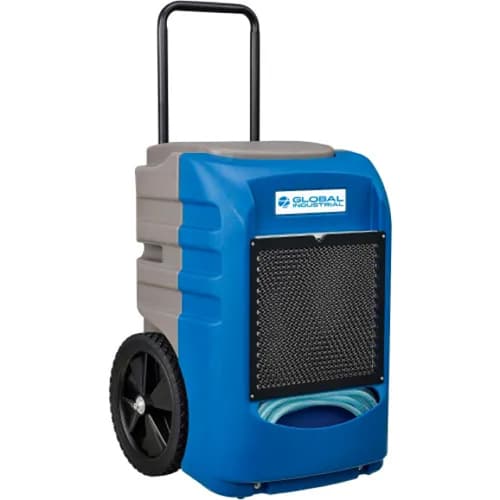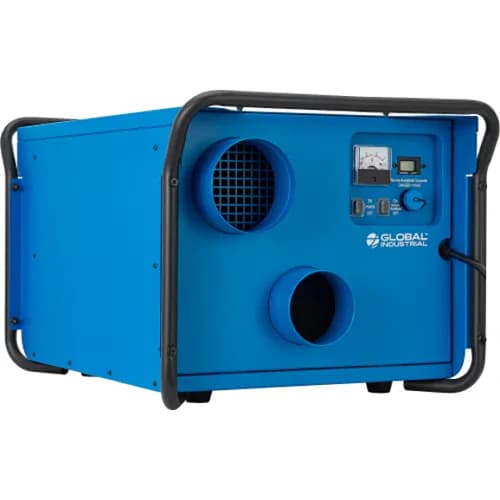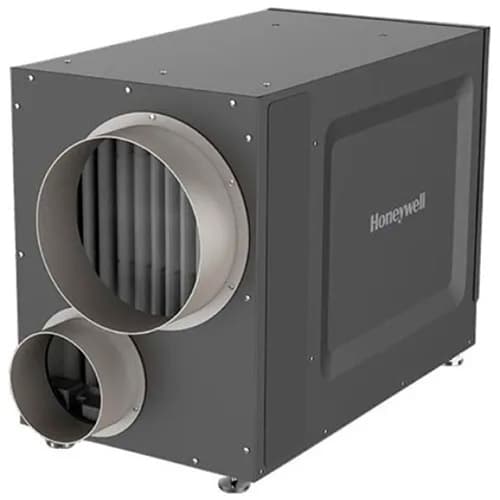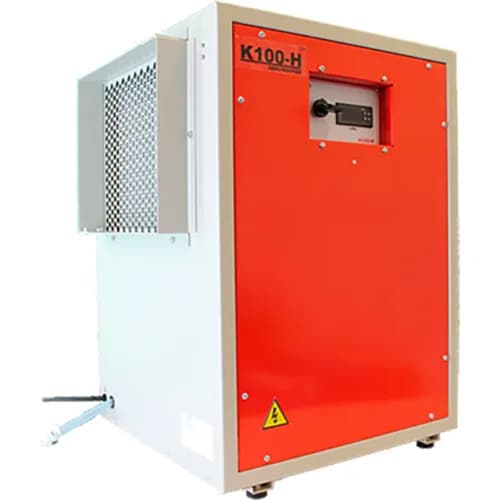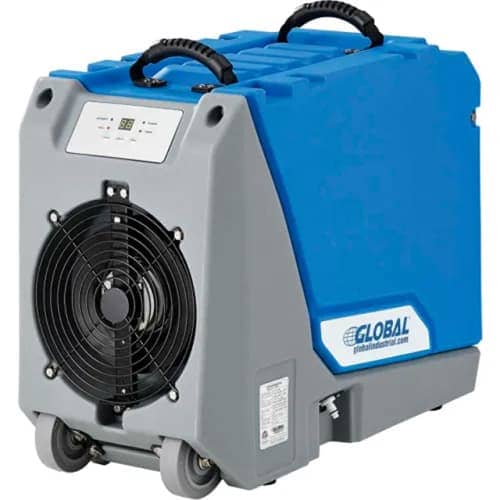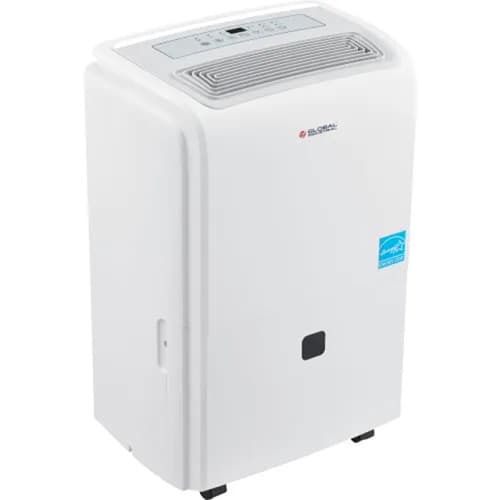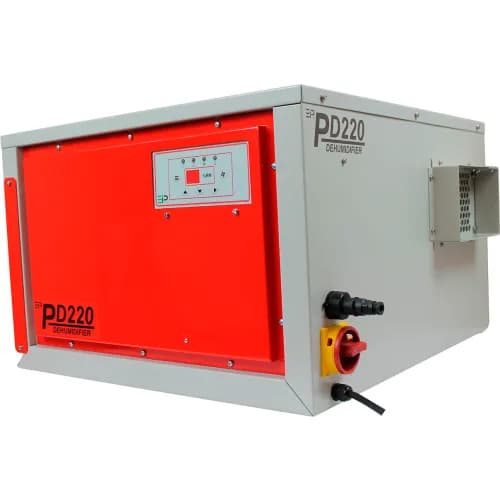Excess humidity in commercial and industrial spaces can compromise safety, increase energy costs, damage equipment, and degrade building infrastructure. Industrial and commercial dehumidifiers are essential moisture control solutions designed to protect assets, improve air quality, and optimize operational efficiency.
There’s a wide range of industrial and commercial dehumidifiers available that are engineered to control humidity levels, reduce maintenance, and keep your operation running like a well-oiled machine. So, let’s take a deeper dive into humidity management systems, from how they work to what model is best for you.
Why Do You Need a Commercial Dehumidifier?
Whether you’re in manufacturing, warehousing, healthcare, data centers, or corporate office environments, controlling moisture levels is one of the most overlooked aspects of workspace maintenance. And yet, it’s so essential for a variety of reasons that range from safety and unwanted damage, to lowering operations costs and maintenance needs.
1: Reduced Costs and Improved Workplace Safety
High humidity in the workplace can lead to increased energy costs, costly damage to facilities, and serious safety risks. By using floor dehumidifiers, HVAC dehumidifiers, and humidity monitors, you can take control of your environment and protect both your bottom line and your people.
- Lower Energy Costs: Dehumidifiers remove moisture from the air, allowing your HVAC system to cool more efficiently and use less energy. These energy-efficient humidity solutions translate into substantial savings.
- Protect Surfaces and Equipment: Moisture buildup can cause floors, ceilings, and work surfaces to swell, crack, or even develop microbial growth that requires expensive repairs. By maintaining humidity levels, you reduce the risk of damage to your facility and equipment.
- Minimize Condensation: Excess humidity leads to condensation on floors and machinery, increasing the chance of slips, falls, and equipment malfunctions. Floor and HVAC dehumidifiers help create a safer, drier environment.
- Simplify Cleaning: Less moisture means less dust, making your cleaning efforts faster, easier, and more effective. And that saves you time and money.
- Control Pests: Many pests, including cockroaches, silverfish, and dust mites, thrive in humid environments. By lowering humidity, you make your space less hospitable to these unwanted intruders.
Investing in the right combination of floor dehumidifiers, HVAC dehumidifiers, and humidity monitors helps you stay ahead of problems, reduce costs, and maintain a safer, cleaner workplace. Explore commercial-grade dehumidifiers designed for demanding environments.
2. Health and Comfort
A dry workspace is a much healthier workspace. High humidity doesn’t just lead to sweaty discomfort; it can quietly wreak havoc on your facility, from warping materials to triggering allergy flare-ups and enabling mold growth. With industrial moisture control, you actively protect your workforce, preserve your assets, and reduce the hidden costs of maintenance, downtime, and health concerns. The major benefits are:
- Air Quality Improvement: Dehumidifiers reduce airborne pollutants, allergens, and contaminants in your facility.
- Allergy Relief: Mold spores and dust mites contribute to allergies and respiratory issues. An energy-efficient dehumidifier helps keep them in check.
- No More Musty Odors: That familiar musty smell? It’s the scent of mold and mildew growing in humid environments. A dehumidifier neutralizes it before it really gets a chance to take hold and become a major issue.
3. Facility and Equipment Protection
Moisture corrodes metal, warps wood, and even destroys expensive electronics. With a powerful dehumidifier, you can stop that damage from happening.
- Preserve Your Building: Excess humidity can lead to mold growth, structural decay, and peeling paint or wallpaper. And that’s not a good look for staff or customers.
- Protect Equipment: Electronics, precision instruments, and other sensitive gear can short out or malfunction in high humidity. A dehumidifier solves that problem.
- Safeguard Office Furniture: From desks to upholstered seating, furniture lasts longer and looks better in a controlled environment.
Types of Dehumidifiers
Not all dehumidifiers are created equal. Here’s a breakdown of the most common types and where they excel.
Refrigerant (Condensate) Dehumidifiers
These units use refrigeration to remove moisture from the air. A fan draws warm, moist air across cold coils, causing condensation that is then collected in a tank or expelled through a drain. However, it’s important to know that refrigerant dehumidifiers are most efficient in higher temperatures. For cooler environments, a desiccant model may be a better fit (see below).
- Standard Refrigerant Dehumidifiers are ideal for warm, humid spaces such as manufacturing facilities or commercial kitchens. A warehouse dehumidifier is a classic example of this.
- Low-Grain Refrigerant (LGR) Dehumidifiers pre-cool the intake air before it reaches the cooling coils. This makes them highly effective in extreme humidity conditions, such as flood recovery zones or disaster restoration settings.
Desiccant Dehumidifiers
These units absorb moisture using a chemical drying agent (often silica gel or a similar substance). Once that unwanted moisture is absorbed, it’s collected in a tank or drained away.
- Perform well in colder climates where refrigerant models struggle: Unlike refrigerant dehumidifiers that rely on cooling coils (which become less effective in colder environments), desiccant models are high performers even in the most chilly or unheated environments. This makes them perfect for garages, crawl spaces, storage facilities, and cold-weather job sites where moisture control is crucial.
- Operate quietly and without compressors: Because desiccant dehumidifiers use a chemical drying agent instead of a refrigeration cycle, they run without those noisy compressors. The result? Much quieter operation, making them a great choice for sound-sensitive environments like offices, libraries, and residential settings.
- Provide consistent drying performance: Whether the temperature drops overnight or fluctuates throughout the day, desiccant dehumidifiers deliver reliable moisture removal without the performance dips. This makes them particularly useful in remote or semi-conditioned spaces where climate control is much harder to achieve.
Whole House Dehumidifiers
These systems integrate directly into your HVAC setup, pulling excess moisture from every room at once.
- Best for large facilities, open offices, or multi-room commercial buildings.
- High-capacity performance makes them the most efficient solution for broad coverage.
- Low maintenance once installed, offering that much-needed “set-it-and-forget-it” functionality.
How to Choose a Dehumidifier.
With so many models on the market, choosing the right industrial dehumidifier starts with understanding your specific working space and operational goals. Let’s break it down:
1. Extraction Rate
Measured in pints per day (PPD), the extraction rate defines how much moisture a unit can remove in 24 hours.
- Larger or wetter spaces require much higher extraction rates. If you have that issue, you’ll need to go for a machine with a substantial PPD.
- Use a hygrometer or humidity meter to monitor real-time relative humidity (RH) levels if your unit doesn’t come with a built-in display.
- The ideal RH for most workspaces is between 40% and 60%. Of course, you can adjust it to your own ideal RH that’s above or below that range.
2. Operating Temperature Range
- Refrigerant models work best in warm spaces.
- Desiccant models are better suited for low temperatures and unheated environments like basements or cold storage areas.
- Always check the product specifications to confirm the operating range.
3. Drainage Options
Collected moisture needs to go somewhere, and how it gets there matters.
- Bucket Collection: Ideal for small or lightly used spaces, but this does require regular manual emptying, so be sure to set reminders for that task.
- Continuous Gravity Drainage: Great for permanent installations where a floor drain is accessible. And there’s no need for manual emptying.
- Built-in Drain Pumps: Highly useful in situations where gravity drainage isn’t possible. In this setup, pumps push water to elevated drains or longer distances.
4. Energy Efficiency
To keep costs down, look for Energy Star-certified units. They’ll save you money over time. Models with adjustable fan speeds and programmable timers also help reduce energy consumption. And whole-house and commercial-grade units may offer automatic shutoff features when the target RH (Relative Humidity) is achieved.
5. Noise Level
In noise-sensitive environments like offices, studios, or clinics, the decibel rating matters. Look for units rated under 60 dB for quiet operation.
Featured Products
Ready to take control of your facility’s air quality? Explore our full range of commercial dehumidifiers and moisture management solutions to protect your people, equipment, and bottom line.
Industrial Dehumidifiers
Engineered for grueling environments, industrial dehumidifiers are the top choice for managing heavy moisture and stifling humidity in warehouses, manufacturing floors, and large storage areas. With extraction rates up to 200 PPD (pints per day), integrated humidistats for humidity control, and heavy-duty casters for easy mobility, these high-capacity dehumidifiers are built for reliability and efficiency in large-scale operations, and are ideal commercial dehumidifiers for warehouses.
Crawl Space Dehumidifiers
Designed to tackle moisture in tight, low-clearance areas and confined spaces, crawl space dehumidifiers feature low-profile builds that can go where standard models can’t. Their high-efficiency performance excels in cooler environments, and continuous drain options help eliminate manual maintenance, making them ideal for mold-prone spaces like basements and subfloor areas to reduce humidity in house.
Small Room Dehumidifiers
Perfect for small offices, tightly-packed server rooms, or storage closets, these compact dehumidifiers combine portability with performance. They’re lightweight, operate quietly to reduce noise disruption, and offer both bucket collection and a drain hose for quick and easy water removal.
Whole House Dehumidifiers
Built to integrate with your facility’s HVAC system, whole-house dehumidifiers provide centralized humidity control across large, multi-room spaces. These bad boys can exceed 300 PPD and with “set-and-forget” digital humidistats, they deliver efficient, continuous humidity control for commercial buildings and warehouses.
Indoor Pool & Spa Dehumidifiers
Designed for high-moisture environments (think indoor pools, spas, and aquatic centers), these industrial dehumidifiers feature corrosion-resistant components and robust internal fans for rapid air turnover. Built for continuous operation under heavy humidity, they protect surrounding structures while maintaining comfortable air quality for guests and staff.
Desiccant Dryer Humidifiers
Ideal for cold, unconditioned, or temperature-fluctuating environments, desiccant dryer humidifiers operate efficiently below 41°F with no refrigerant. Compact and stackable, they’re ideal for use in sensitive areas like pharmaceutical storage, electronics facilities, or food processing zones. What’s more, their low-maintenance, eco-friendly design offers long-term dependability, giving you more bang for your buck.
To sum up, humidity control isn’t a luxury, it’s a necessity. Whether you’re preventing structural damage, safeguarding your equipment, or are just making your workspace more comfortable and efficient, choosing the right dehumidifier makes a huge impact. Visit the Global Industrial Knowledge Center for expert articles on humidity control solutions, selecting HVAC equipment, home dehumidifiers, and optimizing your facility operations. Or feel free to reach out to us here, and we’ll help you make your selection.
The information contained in this article is for informational, educational, and promotional purposes only and is based on information available as of the initial date of publication. It is the reader’s responsibility to ensure compliance with all applicable laws, rules, codes, and regulations. If there is any question or doubt in regard to any element contained in this article, please consult a licensed professional. Under no circumstances will Global Industrial® be liable for any loss or damage caused by your reliance on this article.
